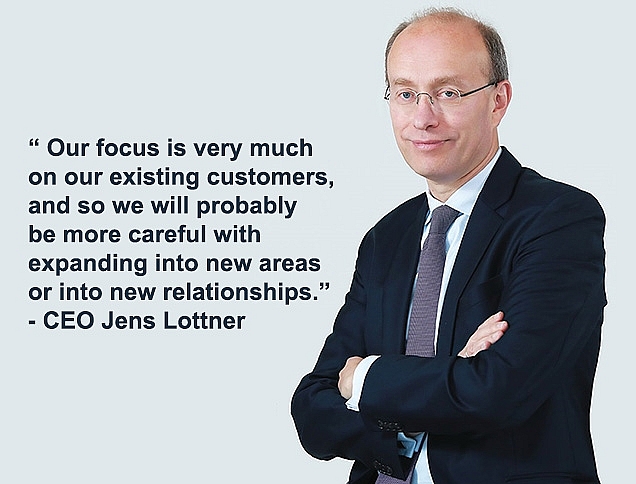Investing in innovation to aid growth potential
 |
| Innovation in banking is not about competition with the rise of fintech – it is more about giving customers the best experience they can get. With that, Vietnamese commercial lender Techcombank has been positioning itself at the forefront of innovation in the country’s financial sector. Understanding this ultimate goal, Techcombank has been tirelessly transforming itself to deliver greater benefits to its customers. With a new CEO at the helm with decades of experience in overhauling and modernising famed banking institutions, Techcombank is speeding ahead in its pursuit for customer excellence through efficient utilisation of technology, data, and the human touch of simply asking the right questions. |
This year you left Siam Commercial Bank (SCB), one of the most prestigious banks in the region. What triggered you to choose Vietnam and specifically Techcombank?
What I enjoy most is constantly changing and building things, helping organisations transform, and shifting into higher gears. I led a lot of transformation efforts at SCB and then became CFO in 2019 when a lot of the foundational elements had been put in place.
But when the offer came from Techcombank to go to Vietnam and help one of the best institutions in the country to become even greater in its pursuit for customer excellence, it was an outstanding opportunity I couldn’t miss.
In countries such as Malaysia or Thailand, sometimes people might have the feeling that they’ve already seen the best of times, which is very different from Vietnam. That always triggered my interest to come to Vietnam.
With both an advisory and financial background, how will you leverage your experience to help Techcombank’s operations, especially the bank’s DNA of being customer-centric?
There are techniques to get to a much deeper customer understanding than just having an individual fill out a survey. If you do ethnographic research, you will actually accompany a customer for a day, observe what he/she is doing, what kind of financial transactions they are doing, and how complicated life can be for a customer to do his or her daily banking. I think we need to get to that level of customer understanding. So I hope that I can encourage everyone to be more questioning on how we are truly helping our customers and not think they know everything.
Ultimately, every bank employee should interface with the customers and not spend time with internal bureaucracy between departments. In order to do that, we need to invest in technology to streamline our processes. At the same time, customers will still want to have human interface, so we need to enable our staff to deliver better experience to our customers.
Where does Vietnam stand now compared to other markets in the region?
Financial services are still very fragmented. There are still a lot of smaller banks in Vietnam compared to some of the other markets right now where the big banks have a much higher share. If you take the top six banks, I believe in Thailand they would constitute above 70 per cent. In Vietnam, it’s probably below 50 per cent. What that means is that it is harder to make the required investments to modernise your business and operating models, as you can’t spread your fixed investments across more companies or customers.
So going forward I expect more differentiation to happen between the leading banks and the rest of the industry, similar to what we have seen in other markets and other industries, like retail for example. And I would expect this trend towards a more consolidated banking industry structure to accelerate as the investments required for staying ahead will rise over time.
 |
What is the pace of tech innovation within Techcombank and what kind of disruptive solutions can it adopt?
Techcombank has always been at the forefront of innovation. The number of customers coming through our digital channels is pretty high compared to a lot of other banks and we are constantly trying to improve it. Technology today allows you to offer wealth management solutions at a fraction of the cost in the past, thereby “democratising” more complex financial products.
Or with credit, in the past you required tremendous amounts of financial data to decide if you want to give a credit to a customer. In a lot of cases this information was not available, incomplete or sometimes not reliable, in which case a bank would not lend. Or it took a lot of effort to collect data, leading to high costs for customers.
Today, you can use so many types of data to increase your ability of providing credit to people who don’t have such a financial track record. That will allow you to finance smaller enterprises at a level which has not been seen before. That is very disruptive, but I think there are only very few banks in the world who have yet fully harnessed the power of these new technologies.
What kind of initiatives will you kick off to help Techcombank get there?
The core enabler for that is data. Data allow us to understand our customers much better than we were ever able to in the past. We are trying to be the best institution in Vietnam when it comes to using technology and data to understand customers. Once we are able to do that, it’s just a question of training people to use that information to continuously create better solutions for our customers.
Banks in Vietnam are still very much behind in terms of innovative technologies in data mining. In fact, very few banks in the world are close to the experience you can get from Amazon or Google. But you can close some of these gaps very quickly. It’s a question of dedication on having the right talent and putting the resources in to collect this data and transform it into insights and ultimately action.
We’re really serious about this and are hiring people who are well ahead in these capabilities to join Techcombank. However, we have to be very clear with customers of what kind of data we’re using, in what context and for what purpose we’re using data. As long as you’re very transparent about it and show the value you can create for the customer, experiences show that most customers are very happy to share.
Large banks or corporations are not as agile as tech startups. What can they do?
Coming up with good ideas and doing things as quickly as a startup is very tough. But adoption is where the difference comes. If you’re a startup, it takes you much longer to convince someone about your product. It’s a race between the innovativeness of the small ones that are much faster to the market but need the adoption at scale, versus the incumbents who need to transform to be faster and have the platforms and financial means to scale up.
Ultimately, it’s about who will bring great solutions to a broad set of the population. It’s unclear who is in a better place. We have examples in China, where the likes of Alipay and WeChat have taken over big pieces. But we also have a lot of other markets where the established banks have transformed themselves to be able to compete very successfully against startups.
What I’ve seen in a lot of situations is you start by competing, but in the end, you will be collaborating. Creating great technology will in turn create a lot of value for customers.
The ones I’m concerned about are the Gojeks, the Grabs, or the Facebooks, because they have a high level of customer interface. Their reach is tens of millions of people in every country. If they suddenly start to become a bank, the results could be quite seismic. These companies are trying to get digital banking licenses in Singapore. In Thailand, Line - which has 40-50 million customers - is starting to set up their own digital bank.
How do you prepare for that in Vietnam?
To be fair, the jury is still out to see if that’s really working. In some markets, even in Singapore and Thailand, it’s unclear which customer problems these new companies are really trying to solve. In markets like Indonesia for example, where Gojek is very strong, they solve a customer problem where banking penetration is not so high and they offer a much more convenient service compared to what banks can offer.
But to give you an example, in Thailand, you can do any kind of payments straight from your banking app. We have not seen big inroads from Alipay, PayPal, or any of these tech giants because there is no real pain point. Gojek and Grab are aggressively going after the financial service play, but they’re paying a lot of acquisition cost.
Is there an intrinsic customer problem in these markets which would not be solved if they would suddenly disappear? Not really. Therefore, I think it’s unclear if it would be sustainable.
In Vietnam, it’s our job to figure out if there’s a customer problem that our existing solutions are not solving. If that’s the case, we really need to do something. The fact that Techcombank has created zero-fee accounts already made it much harder for others to come in. But if a technology can provide mass access to financing, it invites people to come in and start establishing a foothold. And that’s where we need to figure out how we respond.
What are Techcombank’s operational metrics for the second half of the year, and how will you receive new demand arising from the pandemic and support those affected?
Our credit growth will continue the momentum. We will probably see acceleration compared to the beginning of the year. In terms of non-performing loans (NPLs), we’re in a good spot. A lot of our credit exposure is in areas which are less affected by COVID-19. The exposure mainly sits in real estate and mortgages, with relatively less impacted customers. The overall number of NPLs will be very stable.
People are coming out of the crisis with a better handle on it. The stimulus programme by the government was also helping, so we have a lot of liquidity in the market. Some companies have restarted investments and need working capital. In particular, the wholesale banking side will find attractive opportunities.
However, we need to acknowledge that the next year or so will still be very challenging for our customers and hence also for the banking industry. We have already provided a lot of support to our customers in the form of more credit lines, restructuring options, and interest rate reduction. We are monitoring the situation carefully and stand ready to help our customers depending on how the situation develops going forward. Our focus is very much on our existing customers, so we will be more careful with expanding into new areas or into new relationships.
What the stars mean:
★ Poor ★ ★ Promising ★★★ Good ★★★★ Very good ★★★★★ Exceptional
Related Contents
Latest News
More News
- Tax sector wraps up 2025 and sets priorities for next year (December 25, 2025 | 14:00)
- A tipping point for digital and hybrid wealth management in Vietnam (December 23, 2025 | 13:33)
- $250 million deal targets women-owned SMEs, sustainable agriculture (December 22, 2025 | 17:40)
- Stock market posts resilient 2025 performance (December 19, 2025 | 18:17)
- Citi Vietnam receives 2025 AmCham CSR recognition (December 19, 2025 | 16:35)
- As global green supply chain reshapes, will Vietnam be left behind? (December 19, 2025 | 08:00)
- Banks gear up for massive capital increases (December 18, 2025 | 17:04)
- Securing capital and efficiency for Vietnam’s 2026-2030 growth ambitions (December 17, 2025 | 10:00)
- Energy sector in need of blended finance mechanisms (December 17, 2025 | 09:00)
- Vietnam still has room to mobilise capital for sustainable growth (December 17, 2025 | 08:57)

 Tag:
Tag:




















 Mobile Version
Mobile Version